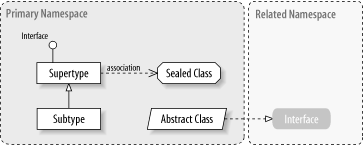| [ Team LiB ] |
|
21.1 Finding a Quick-Reference EntryThe quick reference is organized into chapters, one per namespace. Each chapter begins with an overview of the namespace and includes a hierarchy diagram for the types ( classes, interfaces, enumerations, delegates, and structs) in the namespace. Following the overview are quick-reference entries for all the types in the namespace. Figure 21-1 is a sample diagram showing the notation used to depict hierarchies and their relationships. Abstract classes are shown as slanted rectangles, and sealed classes as octagonal rectangles. Inheritance is shown as a solid line from the subtype, ending with a hollow triangle that points to the supertype. There are two notations that indicate interface implementation. The lollipop notation is used most of the time because it is easier to read. In some cases, especially where many types implement a given interface, the shaded box notation with a dashed line is used instead. Figure 21-1. Class hierarchy notation Important relationships between types (associations) are shown with a dashed line ending with an arrow. The figures don't show every possible association, but only those considered most important to developers. Entries are organized alphabetically by type and namespace, so that related types are grouped near each other. Thus, in order to look up a quick-reference entry for a particular type, you must also know the name of the namespace that contains that type. Usually, the namespace is obvious from the context, and you should have no trouble looking up the quick-reference entry you want. |
| [ Team LiB ] |
|